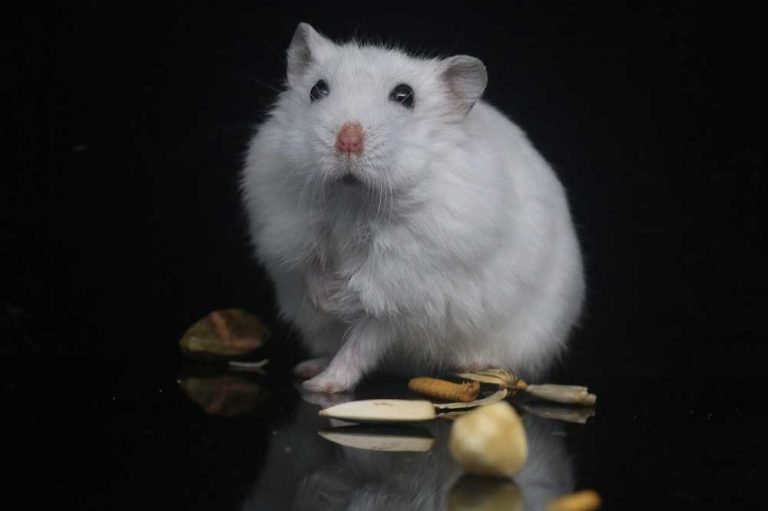All About Hamster Cheek Pouches – Potential Health Problems & Care Tips
You’ve known your hamster to be a slow-eater. You offered him some food and in no time there was nothing remaining in their bowl. The look on his face even signaled that he was ready for more. “But that was so quick!” You wonder.
Well, hamsters have something known as cheek pouches that they use to hoard food for later consumption. Now, today we are going to talk more about these pouches. We will look at their sizes, number, what they can store, common potential health problems, and how best to take care of them.
And just before we get deeper into all that, let’s begin with the most apparent question:
What Are Cheek Pouches?
Cheek pouches are expandable sacs located on each side of a hamster’s mouth. These structures are between their cheeks and jaws, and they store food inside.
The pouches are formed by a fold of skin that runs from the hamster’s jaw to its cheeks. These structures run from the hamster’s mouth to its shoulders and are quite stretchy, allowing for large quantities of food to be stored.
When the hamster needs to use whatever is stored inside, they push out one of their cheeks with their paws and retrieve whatever it is. This is why hamsters are sometimes called pocket pets.
How Big Are Hamster Cheek Pouches?

Cheek pouches vary in size. According to scientists, those tiny pockets that bulge on the sides of your hamster’s face can actually stash about a third of their body weight in a single seating.
However, as earlier said, they are highly elastic and will expand across the shoulder blades when full. The high elasticity comes in handy, especially considering that hamsters mostly live in deserts where there’s no assurance that food will be available at all times.
How Many Cheek Pouches Does a Hamster Have?
All hamsters have two cheek pouches, one on each side. That’s much more like you will find in other small “cheeky” rodents, for instance, chipmunks and squirrels.
Amazingly, even when these cheek pouched are stashed to capacity, hamsters can still walk around with ease, run from their predators, and even climb without any problem.
What Do Hamster Cheek Pouches Store?
Hamsters use their cheek pouches to store seeds, nuts, grains, and other small animal parts that they find when foraging for food. Once they’re full, the hamster takes them to their nest or burrow and stores all that food inside.
They will then feed on these stashed morsels whenever they’re hungry, guaranteeing a constant supply of nourishment even during winter when food is scarce.
But food isn’t the only thing hamsters can hold in their pouches- they can also use them to carry their babies! Hamster pups are usually born without fur, and for this reason, they need additional warmth.
The mother hamster has the ability to carry her young in her cheek pouches where they can stay nice and warm until they reach six weeks of age (when they already start growing fur).
You may also have noticed your hamster stuffing these pockets with their bedding. Well, that’s also another thing that hamsters commonly use these pouches for, and that’s why you should be careful with the bedding that you provide for your hamsters.
Common Hamster Cheek Diseases

Hamster cheeks are not only cute but also very useful, just as earlier seen. However, their pouches are vulnerable to certain diseases, which can compromise their usefulness and the well-being of your hamster pet as a whole.
Some of these diseases include:
Tumors:
The first cheek disease that your hamster pet is likely to contract is a tumor. Tumors develop when the cheek pouch becomes inflamed, and it will begin to expand until it reaches its maximum capacity.
If this happens, your hamster’s life might just be at risk, as they have been known to cause paralysis in some cases. When your hamster’s cheek pouches have tumors, they will have a different feel than when filled with food.
Tumors are caused by an infection in the mouth. In most cases, you can treat them by taking your hamster to a vet and having it checked up.
Abscesses
If the tumor isn’t treated on time or if it’s left untreated altogether, your hamster will eventually get an abscess, which is basically a pocket of pus that forms inside the cheek pouch due to bacterial infection.
Abscesses can be rather painful for your pet hamster, and they will develop red lumps on the area where they are located. Your hammy may also find it hard to eat and play as used to.
To treat an abscess, you will need an exotic vet, though it usually takes a relatively long time before it heals. When left untreated, this condition can spread to other parts of the body causing more issues.
Impactions
Hamsters are often seen swallowing various objects, and it’s not uncommon for them to swallow too many. Their cheek pouches are perfect for holding all that before they can eat or store them away.
However, sometimes hamsters will accidentally swallow something that is too big for them to get out. But it always doesn’t have to be about the size, even sticky substances can get stuck inside these pouches.
What follows is the food (or nesting material) beginning to rote in their cheek pouches and eventually develop an abscess, which we’ve already seen what it’s capable of causing.
Eversion (Inside-Out Pouches)
The other cheek pouch condition that hamsters are likely to suffer is eversion. This happens when the cheek pouches flip out of the mouth. It’s much more like what happens to your pant pockets when you remove something big from them.
The condition is easy to spot as the pouches will appear like actual flesh that hangs outside your hamster’s mouth. The cause isn’t well known, but the good thing is that this condition can easily be treated by vets.
The vet will put the pouch back in place in a way that it won’t come out again when your hamster begins to disgorge the pouch contents. However, before the vet shows up, keep your hamster safe in contamination-free environments.
How To Keep Your Hamster Cheek Pouches Healthy
Although most of the conditions that hamster cheeks can be treated, it’s always best to take prevention measures.
Sure, you may not do much to keep your pet from overstuffing their pouches, but at least you can do something to ensure that what they do doesn’t cause them much trouble later on.
Here are the measures to take to keep your hamster pouches healthy:
- Know your pet and how the cheeks look like when stuffed. That will help you know when there is an abnormality.
- Avoid giving your pet sticky foods. These types of foods can get stuck inside the pouches and cause severe damage.
- Make sure that you keep a close eye on your pet every day. Examine your hamster’s mouth and pouches regularly.
- Be vigilant enough to notice any odd smell that may come from your hamster’s mouth. That will help you notice any infections early on.
- Visit a vet occasionally for a more thorough examination. This will help pinpoint any pouch diseases right at their early stages. Your vet may also discover other conditions hard to notice.
Final Verdict:
Hamster cheek pouches can be used to store food and other necessary items, but sometimes they get in the way of your pet’s health. As we’ve seen previously, hamsters can suffer from various cheek pouch diseases that can lead to severe issues if ignored.
Knowing how to take care of your pouches and what these conditions look like will certainly help you monitor your pet’s cheek pouches and keep them as healthy as possible.


![Are Hamsters Nocturnal or Crepuscular? [What Are They Really!]](https://atractivopets.com/wp-content/uploads/2021/03/Hamster-768x511.jpg)




